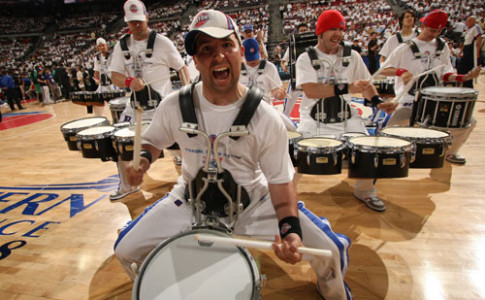Sometimes 1 + 1 is greater than 2. When multiple bands join forces—whether permanently or temporarily—synergies develop to create a better experience for students and staff.
When the marching bands from Normal West High School and Normal Community High School from Normal, Illinois, combined in 2018, they had many decisions to make—including where to practice and how to combine traditions.
“The increased opportunities for student and staff collaboration, team-building, and leadership were guiding factors in the decision in addition to the optimal use of staffing and resources within our school district,” says Ryan Budzinski, building music department chair and director of bands at Normal West High School.
Many factors such as size, budget, and other resources may come into play when deciding whether to combine multiple bands, but once the merger is announced, the back story surrounding the decision becomes much less important than future plans.
Forming New Traditions
 Logistically for the Normal Marching Band, the combined ensemble practices at one of the town’s junior high schools because it is more centrally located than the high schools.
Logistically for the Normal Marching Band, the combined ensemble practices at one of the town’s junior high schools because it is more centrally located than the high schools.
“We are utilizing [the junior high] as our new home base and have parked both schools’ previous equipment trailers and a storage unit there,” Budzinski says. “Because of the size of the group, in cases of extreme heat or inclement weather, we have also utilized the indoor facilities at the high schools. While it is great to have those options available, it requires advanced planning and diligent communication.”
Overall, the experience has been positive for both staff and students. “Students have forged new relationships and had the ability to learn from one another and from a larger staff with a diverse set of experiences to contribute,” Budzinski says. “In any transition of this magnitude, flexibility and a willingness to adjust are key, but the group has made every effort to pay respect to both schools’ rich histories while embracing the privileges of setting new traditions and representing our schools, school district, and community in a new way.”
The combined marching band hasn’t affected the structure of the other performance bands at the high schools. “Both schools’ marching bands were previously extracurricular, and the new group continues to be,” Budzinski says. “The Normal Marching Band has had no effect on the structure of our concert bands, which meet during the school day all year.”
If your district is thinking about combining marching bands, discuss logistics early and often. “We would advise that they begin the process as early as possible to allow time for planning,” Budzinski says. “Communication, administrator approval, facilities, scheduling, budgeting, merging/developing boosters, planning for uniforms and so on … all of that happens separately from the important conversations about instruction and design.”
Burying a Long-Standing Rivalry
 In 2015, the West Shore School District in New Cumberland, Pennsylvania, voted to merge the marching bands at both of the high schools. Music teachers in West Shore’s Cedar Cliff High School and Red Land High School strongly supported the idea.
In 2015, the West Shore School District in New Cumberland, Pennsylvania, voted to merge the marching bands at both of the high schools. Music teachers in West Shore’s Cedar Cliff High School and Red Land High School strongly supported the idea.
“One marching program was struggling to maintain the level of excellence they were accustomed to; the other was thriving [mainly because of] financial support, available quality staff, student enrollment, parental involvement, and equipment,” says Robert Starrett, West Shore Marching Band director. “It made sense that we used the available financial resources we had in our district more efficiently by funneling them into one marching band.”
On the other hand, the community feared loss of identity and struggled with the idea of one district-wide marching band because a long-time rivalry had existed between the schools.
“Many didn’t want this to happen just because they felt it was wrong to mix the schools, but we knew once the kids got on the field together—practicing, marching, working—the need to hold onto the rivalry would quickly dissipate, and that is exactly what happened,” Starrett says. “We forged a new identity that represents our entire school district, and we are proud of that.”
The band instructors sought help from students during the transition. “We made a point to have our student leaders choose traditions from both programs to maintain and ones to let go,” Starrett says. “Empowering our students to be involved in this particular process was crucial to getting over the identity factor.”
The music directors also made certain decisions with parents in mind. “We chose to use both schools for practices, so one set of families didn’t always have to drive more than the other,” Starrett says. “Housing percussion equipment at one location was a solution for efficiency, but it also means percussion families from Red Land must always travel to Cedar Cliff to practice. We chose to hold indoor percussion at Red Land during the winter to balance the travel issue.”
If your district is thinking about combining marching bands, consider how the merger will affect the entire community. “Take the plan to all stakeholders and vet the plan with each of them, plan ahead, and empower student leaders,” Starrett says. “The administration and community of West Shore now use the West Shore Marching Band as an example and inspiration to thinking outside of the box to resolve issues [and] as proof that staff, students, and communities can work together to achieve a common goal.”
Joining for Special Events
In 2010, Deer Park (Washington) High School and Riverside High School in Chattaroy, Washington, temporarily combined to become one large band. Music educator Brian Comstock had been directing Riverside’s band program for several years, but his schedule had been cut back for budgetary reasons. Around the same time, Deer Park’s band was dwindling and needed a leader. Comstock was asked to direct the bands at both high schools even though they were in separate school districts.
For two years, Comstock combined the Riverside and Deer Park bands for every performance, including appearances in the annual Spokane Lilac Festival Armed Forces Torchlight Parade, a local televised event. Then Comstock took a teaching position elsewhere, and the Riverside and Deer Park school districts replaced him with two teachers. The bands performed separately again although they have continued to join forces for the Lilac Festival’s annual parade since 2012.
“Though Riverside and Deer Park High Schools are sort of friendly rivals when it comes to athletics, our students have developed a camaraderie with each other,” says Taylor Belote, the current band teacher at Deer Park High School. “It has developed into a fun tradition for us to combine for this event each year. Our combined high school marching bands have received the Gold Standard award at our local parade almost every year.”
When both bands combine, they look larger and sound stronger, but they benefit in other ways too. “With two different directors, [we] can also bring our different musical or instrumentation strengths when we join forces,” Belote says. “I’m a drummer with lots of drumline experience, so Deer Park usually brings a pretty strong drumline, and [Dan Carlson, Riverside’s band director until recently,] is a great saxophone player that has often had more saxophones and mid-range winds than I have had.”
The bands do most of their practicing separately, so it’s crucial for the teachers to be on the same page. “As we rehearse things separately with our different schools, [we have to] make sure we are teaching certain concepts the same way,” Belote says. “We have to make sure we are aligned in all of our verbal drum major commands, marching techniques, step style, carriage/posture, count-offs to the parade tunes, the ways the band marches around corners, musical concepts like articulation, dynamics, and phrasing of the music we play.”
During the week of the Lilac Festival, the bands combine for three rehearsals. On the day of the parade, each high school uses separate buses to get their students and equipment downtown.
“We meet at Riverside High School and caravan down together, so we can enter the parking lot together and stay with each other for the whole event,” Belote says.
The two bands wear their own school uniforms—with different jackets—though black pants, black shoes, and black shakos help the bands look more cohesive.
If your district is thinking about combining marching bands, the way instructors work together is an important factor. “Make sure both schools and directors are on the same page from the beginning, and you can combine bands with very little rehearsal time and still have a fantastic performance product,” Belote says.


